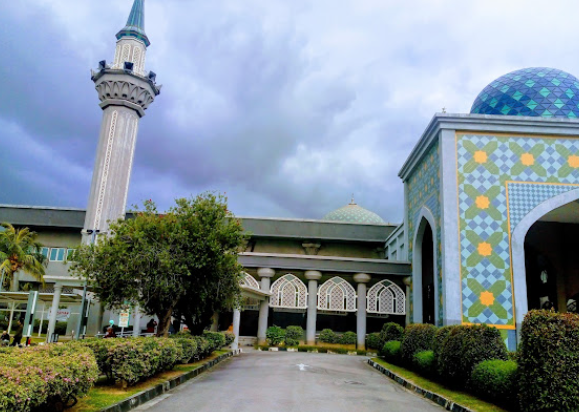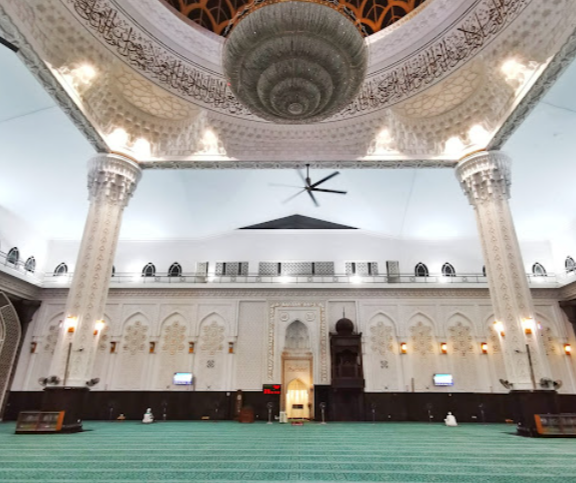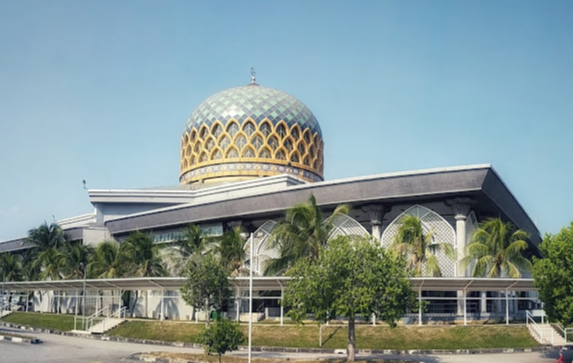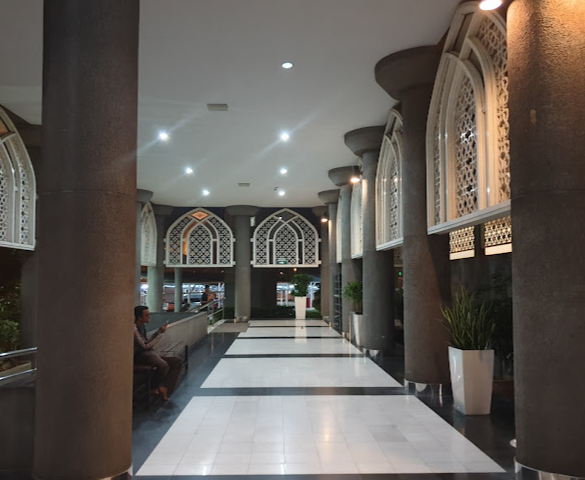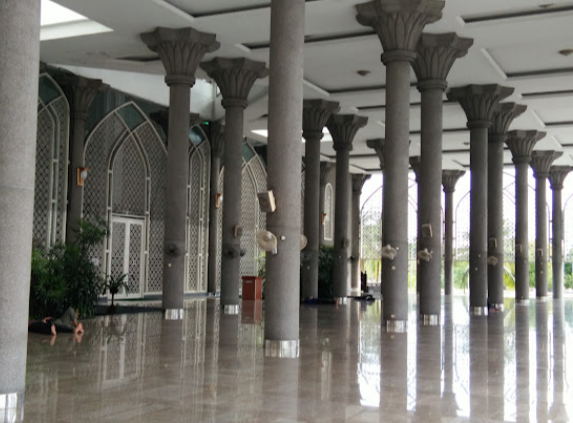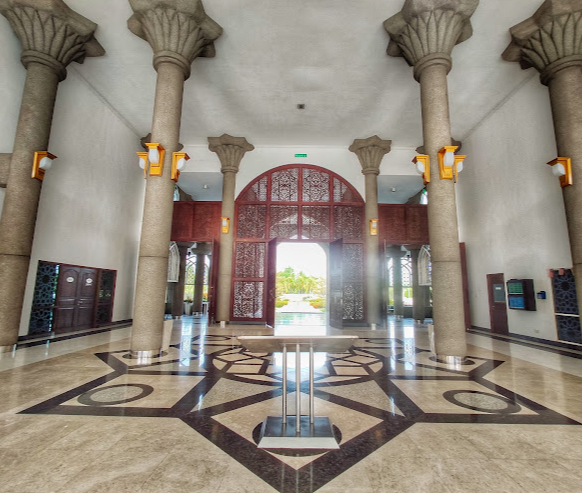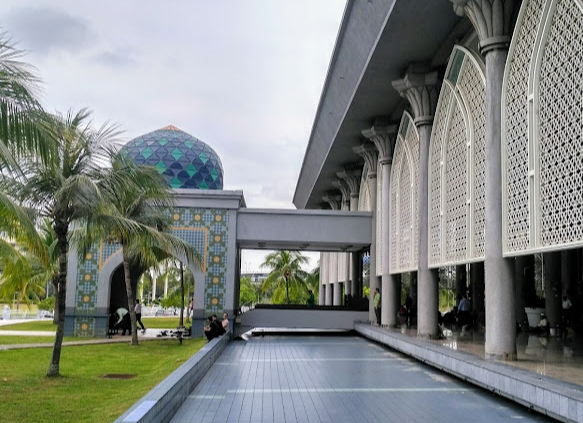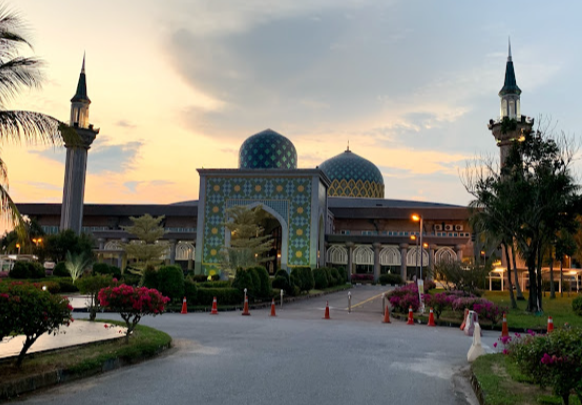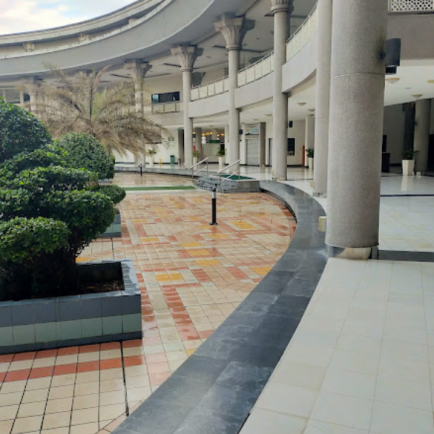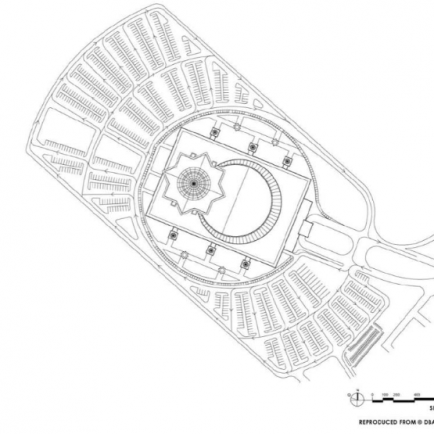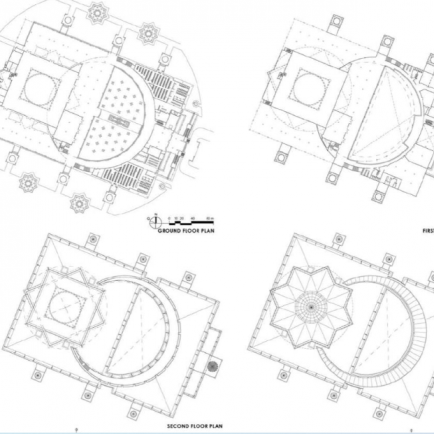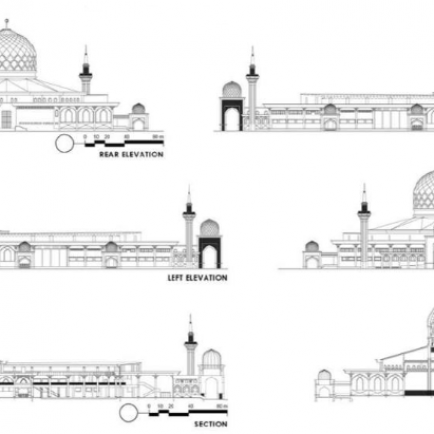Sultan Abdul Samad Mosque
History
The opening of the KLIA on 27 June 1998, while the construction of the mosque began in 1997 and was completed in 1999. The mosque was officially opened on 12 August 2000 by the Regent of Selangor at that time, Tengku Idris Shah (now Sultan Sharafuddin Idris Shah).
Urban and Architectural
The mosque was inspired by a local herb flower, bunga kantan or commonly known as the ginger flower.
The postmodern approach is apparent through the use of the high-pointed dome, clad with bluish glazed finish of its dome and the unique application of stained glass clerestory windows at the base of
the dome. The main dome is regarded here as a ‘living dome’ and sits in the middle of a sloping roof in the form of the Islamic geometrical star. It is flanked by two minarets and eleven smaller domes indicated along the side entrances and outdoor ablutions.
The glass clerestory windows of the dome add uniqueness to the mosque, apart from its exterior floral motif design. It allows natural lighting to illuminate the interior of the mosque. It creates a floral shadow play inside the prayer hall, and moves along with the changing angles of the sun. The reverse effect takes place during the night, as the illuminated dome looks like a lantern being lit and acts as a beacon to the travelers and passersby. The mosque’s layout design symbolically represents the Islamic star and crescent emblem. It can be seen from a bird’s eye view or on its site plan. The curve-shaped crescent moon emblem provides space for a corridor that connects the support and office areas to the veranda areas and the main prayer hall building.
The emblem of the crescent also encircles the internal courtyard area, and is often used as a transitional space between the entrance and main prayer hall. The courtyard or sahn is fringed by an arcade or riwaqs, which symbolically gives the impression of an exterior landscape entering into the interior space before transforming into decorative columns inside the main prayer hall.
The main prayer hall is beautifully crafted in a white gypsum finish, with the built-in mihrab niche and elevated wooden minbar platform. The expanse space is characterised by a series of blind arches on the front qibla wall, with a grand chandelier that hangs in the middle of the hall, right under the pinnacle of the dome.
Description
The mosque was named as the Sultan Abdul Samad Mosque, in honour of the fourth Sultan of Selangor, Sultan Abdul Samad. This modern mosque is a design undertaken by a Malaysian architectural practice, DBA Arkitek.
References
https://en.wikipedia.org/wiki/Sultan_Abdul_Samad_Mosque
https://itc.gov.my/listings/masjid-sultan-abdul-samad-klia/
Details
الموقع
Jalan Pekeliling, 43900 Klia, Selangor
عدد المصليين
8,000
المالك / المتبرع
the Malaysia Airports Holdings Berhad
المعماري
تاريخ البناء
1999
Area
14,977
الرسومات المعمارية
الخريطة
History
The opening of the KLIA on 27 June 1998, while the construction of the mosque began in 1997 and was completed in 1999. The mosque was officially opened on 12 August 2000 by the Regent of Selangor at that time, Tengku Idris Shah (now Sultan Sharafuddin Idris Shah).
Urban and Architectural
The mosque was inspired by a local herb flower, bunga kantan or commonly known as the ginger flower.
The postmodern approach is apparent through the use of the high-pointed dome, clad with bluish glazed finish of its dome and the unique application of stained glass clerestory windows at the base of
the dome. The main dome is regarded here as a ‘living dome’ and sits in the middle of a sloping roof in the form of the Islamic geometrical star. It is flanked by two minarets and eleven smaller domes indicated along the side entrances and outdoor ablutions.
The glass clerestory windows of the dome add uniqueness to the mosque, apart from its exterior floral motif design. It allows natural lighting to illuminate the interior of the mosque. It creates a floral shadow play inside the prayer hall, and moves along with the changing angles of the sun. The reverse effect takes place during the night, as the illuminated dome looks like a lantern being lit and acts as a beacon to the travelers and passersby. The mosque’s layout design symbolically represents the Islamic star and crescent emblem. It can be seen from a bird’s eye view or on its site plan. The curve-shaped crescent moon emblem provides space for a corridor that connects the support and office areas to the veranda areas and the main prayer hall building.
The emblem of the crescent also encircles the internal courtyard area, and is often used as a transitional space between the entrance and main prayer hall. The courtyard or sahn is fringed by an arcade or riwaqs, which symbolically gives the impression of an exterior landscape entering into the interior space before transforming into decorative columns inside the main prayer hall.
The main prayer hall is beautifully crafted in a white gypsum finish, with the built-in mihrab niche and elevated wooden minbar platform. The expanse space is characterised by a series of blind arches on the front qibla wall, with a grand chandelier that hangs in the middle of the hall, right under the pinnacle of the dome.
Description
The mosque was named as the Sultan Abdul Samad Mosque, in honour of the fourth Sultan of Selangor, Sultan Abdul Samad. This modern mosque is a design undertaken by a Malaysian architectural practice, DBA Arkitek.


